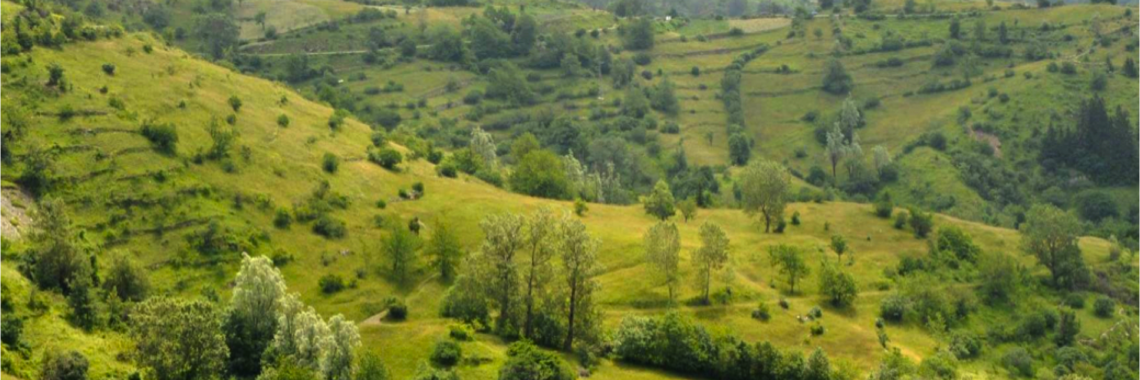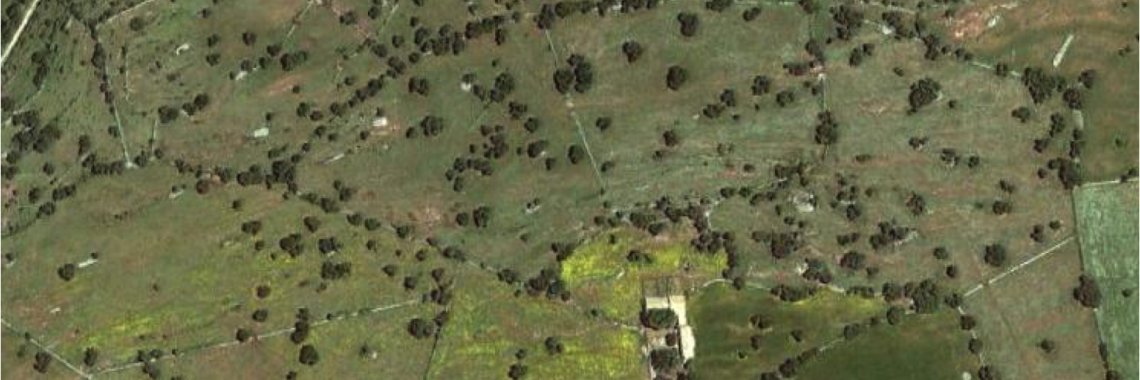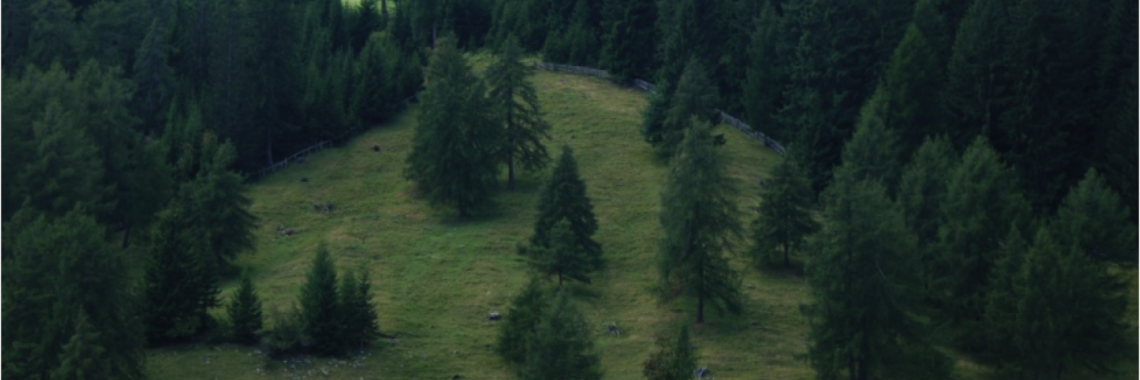Wooded grasslands in Italy
26.07.2017, by Bénédicte Gaillard
Research: Antonio Santoro, Mauro Agnoletti, Francesca Emanueli, Maurizia Sigura, upload: Bénédicte Gaillard. The entries are still in process
The first informations about Italian wooden pastures date back to XVI century, when these land uses were listed in some maps of central Appennines, as in Molise, Abruzzo and Tuscany, where there was a pastoral system based on grazing and on the leaves coming from the pollarding of the trees that grown on the pastures.
These pastures have an anthropic origin, related to the historical and economic situation of the local people, that modified the surrounding environment to obtain services and food. They had few economic resources and so they created systems that were able to provide all the goods they needed, as food, pastures for the animals, firewood, fruits. These agro-silvo-pastoral systems were ecologically and energetically sustainable. Due to the various climatic and geographic situations that can be found in Italy, we have different kind of wooden pastures throughout the nation.
Trentino Alto-Adige; In the Alps of Trentino Alto Adige can be found one of the biggest wooden pastures with larches of Europe, in a place called Salten. This word comes from the Latin word saltus, used for describing a landscape characterized by open spaces with trees used for grazing in the middle of large woodlands. The fact that the name of this place reminds to such a Latin word means that this landscape date bake to 2000 years ago.
Tuscany; In the Tuscan Cadastral Registry of 1832 a lot of woods were classified as pasture woods, and they represent the 45% of all the land used for grazing in the mountainous areas. Since the beginning of XX century, the 90% of the woods of Tuscany were regularly grazed, and they supported up to 50% of the livestock of the farms.
As the data for XIX century collected for some mountainous areas of the Tuscan Landscape Monitoring System, the wooden pastures covered the 11% of the analyzed area. Due to the abandonment of traditional activities, this land use decreased by 88% from 1832 to 2002. Most of the wooden pastures investigated (the 67%) have been covered by shrubs and trees and became woodlands, after they were no more grazed. The 25% were instead turned into cultivations.
Traditionally the trees founded on wooden pastures were oaks, and they were managed in different ways.
Some of them were pollarded at 2-3 meters from the ground, especially in the Maremma, an area in southern Tuscan near the sea. This way of managing the trees allowed to left the animals on the pastures, in fact they couldn’t reach the new branches and leaves with their bite. The trees provided firewood, leaves and acorns, and they were about 8-10 meters apart from each other so the ground could receive enough light from the sun.
The silva fructifera or silva glandaria was also cited by Cato the Elder in 53 b.C. in his De Agricoltura, as the most important way to increase the benefits for a farm. The main production of these wooden pastures was related to acorns that were the main food for the pigs that grazed on the pasture. Usually these pastures were very common, but their surface was small, until the beginning of XX century in different areas of Tuscany (Mugello, Valdarno e Casentino). The density of the trees was between 50 and 170 trees/hectare. Every year one or two plants per hectare were cut, chosen among the trees that showed signs of decline and lower acorns production. The lack of natural renovation was remedied with the seeding; the new plants were usually protected from the livestock bite by shrubs with thorns. The shrubs were usually cut to let the ground clean for grazing and to facilitate the collecting of the acorns that were used for feeding the pigs during the winter months.
Liguria; In the Ligurian Apennines between XVIII and XIX century local people used a very long cycle (12 years) where wooden pastures with Grey Alder and other species were alternated to cultivations, in mountainous areas with very poor soils.
a) First the grey Alders on the pastures were coppiced and some of them used as firewood by the local people.
b-c) Then the remaining wood was burned on the pasture and the ashes were dispersed on the ground to fertilize it; the fire, covered by soil to protect the trees, was also used for clearing the ground from shrubs.
c) The land was then cultivated for 2-5 years while the alders grow.
d) When the alder were grown enough not to be damaged, sheep and goats were allowed to graze.
Central-southern Appennines; In Abruzzo the difese were the wooden pastures on public lands used by the local population for breeding or for collecting firewood and acorns. Traditionally the trees on the pastures were pollarded at 2.5-3 meters for keeping new branches and leaves apart from the bite of the animals.
Sardinia; The salti of Sardinia were wooden pastures for public use. The Latin word saltus become, according to Festus, from the world used for a jump, a gap. In fact it was used for open spaces used for grazing, in the middle of woods.
Since ancient times the land that legally belonged to the villages and that where close to it, were used as agricultural areas (called vidazzone) or for the grazing of domestic livestock (called paberile). The public lands far from the villages were called saltus, and were used for the grazing of cattle or pigs and for collecting firewood. Grazing was allowed only when the acorns were on the ground.
Sicily; The wooden pastures in the Ragusa province date back to XIV century, when the lands of the latifudio were divided among the farmers. One of the main features of these wooden pastures is that there are circular dry stone wall surrounding the carob trees for protecting them from the animals. Other dry stone walls are used for dividing the pastures. The trees are mainly used for the carob fruit as food for the cattle and for providing shade during the hot summer months.
Overall, the surface covered by wooden pastures in Italy has decreased during the last 150 years mainly because of the abandonment. These land uses were in fact usually founded in mountainous areas or in places with harsh climatic conditions and poor soils. These places were the first ones to be abandoned by local population after the Second World War. The abandonment of pastures caused the increase of the forest surface and a loss of biodiversity at the landscape scale. In 1861 pastures covered about 6.113.000 hectares while actually they cover only 3.346.951 hectares.
Afan De Rivera C., Considerazioni sui mezzi da restituire il valor proprio a'doni che la natura ha largamente conceduto al Regno delle Due Sicile, Napoli, 1842
Alias S., Bianchi L., Calamini G., Campus S., Gregori E. – I pascoli arborati in Sardegna. Un caso in provincia di Nuoro. Sherwood, 141 (3), 2008
Beccu E., Tra cronaca e storia le vicende del patrimonio boschivo in Sardegna, C. Delfino, Sassari, 2000
Bertolotto S., Cevasco R., The ' Alnocolture' System in the Ligurian Eastern Appennines: Archive Evidence, in Agnoletti M., Anderson S. (a cura di), Methods and approaches in forest History, CABI Publishing, UK, 2000, pp. 190-202
Bevilacqua P., Bosco di Sant’Antonio, Agnoletti M., (a cura di), Paesaggi rurali storici per un catalogo nazionale, Editore Laterza, 2010
Biasi R., Prati e pascoli arborati di Salten, in Agnoletti M. (a cura di), Paesaggi rurali storici per un catalogo nazionale, Editori Laterza, 2010
Biblioteca degli scrittori latini, Opere di M.Porcio Catone con traduzione e note, Tip. Giuseppe Antonelli, Venezia, 1846 (De Re Rustica I
Bortolotti L. – Problemi di conservazione dei pascoli arborati («difese») d’Abruzzo, in “L’Italia Forestale e montana”, 45 (1985), pp. 65-72.
Brilli A. – Lo spirito della campagna toscana, Istituto di credito agrario, Firenze, 1992
Carrante A. – Il miglioramento dei pascoli murgiosi, in “La propaganda agricola: bollettino quindicinale della Cattedra ambulante di agricoltura della provincia di Bari”, 12 (1909), pp. 182-185.
Carrante A. – Come rimboschire le Murge, in “La propaganda agricola: bollettino quindicinale della Cattedra ambulante di agricoltura della provincia di Bari”, 13 (1909), pp. 212-214.
Carrante A. – Il rimboschimento con piantine, in “La propaganda agricola: bollettino quindicinale della Cattedra ambulante di agricoltura della provincia di Bari”, 14 (1909), pp. 239-241.
Carrante A. – Gli utili del pascolo arborato, in “La propaganda agricola: bollettino quindicinale della Cattedra ambulante di agricoltura della provincia di Bari”, 16 (1909), pp. 300-301.
Cevasco R. – Memoria verde. Nuovi spazi per la geografia, DIABASIS, Città di Castello (PG), 2007.
Cevasco R., Pascoli arborati di Roccaverano, in Agnoletti M., (a cura di), Paesaggi rurali storici per un catalogo nazionale, Editore Laterza, 2010.
Cossu A., Indagine sui pascoli della Sardegna: lavoro eseguito per conto della Commissione economica di studio per la rinascita della Sardegna, Gallizzi, Sassari, 1961.
D’Errico P. – Alpicoltura 1 e agricoltura montana: anno accademico 1970-1971, Facoltà di Agraria, Bari, 1971
Del Favero R.– I boschi delle regioni meridionali e insulari d'Italia: tipologia, funzionamento, selvicoltura, CLUEP, Padova, 2008
Del Noce G., Trattato istorico, scientifico ed economico delle macchie e delle foreste del Granducato di toscana con un nuovo regolamento delle acque fluenti per i fianchi scoscesi delle montagne appennine e delle centrali, G. Ducci, Firenze, 1849
De Ricci L., Delle scarse rendite dei querceti ghiandiferi e dei metodi per aumentarli, in “Giornale Agrario Toscano”, 4 (1830), pp. 320-326
Dettori S., Pascoli arborati del Monte Minerva, in Agnoletti M., (a cura di), Paesaggi rurali storici per un catalogo nazionale, Editore Laterza, 2010.
Di Berenger A. – Dell’antica storia e giurisprudenza forestale in Italia, Longo, Treviso–Venezia, 1859-1863
Gabbrielli A. – Selvicoltura toscana nel ’700. Parte prima, in “Annali Accademia Italiana Scienze Forestali”, 29 (1980), pp. 211-242
Gautieri G. – Quando e come abbiasi a permettere il pascolo nei boschi si resinosi che da fronda, si d’alto fusto che cedui, G. Silvestri, Milano, 1813
Iacini S. – Atti della Giunta per la inchiesta agraria e sulle condizioni della classe agricola. Volume III, Fascicolo I, Forzani e C. Tip. Del Senato, Roma, 1801
Le Monnier, Firenze, 1996
Merendi A., Il problema forestale nel territorio del Chianti, in Convegno del Chianti. Atti Firenze 25-26-27 maggio 1957 Accademia Economico-Agraria dei Georgofili, Tip. Vallecchi, Firenze, pp. 228-261
Merendi A. – Boschi e pascoli nella Provincia di Firenze, in Petrocchi B., (a cura di), L’agricoltura nella Provincia di Firenze, G. Carnesecchi, Firenze, 1927
Moreno D. – Dal documento al terreno. Storia e archeologia dei sistemi agro-silvo-pastorali, Il Mulino, Bologna, 1990.
Moreno D., Poggi G., Storia delle risorse boschive nelle montagne mediterranee: modelli di interpretazione per le produzioni foraggere in regime consuetudinario, in Cavaciocchi S., L'uomo e la foresta secc. XIII-XVIII: Atti della ventisettesima settimana di studi, 8-15 maggio 1995
Moreno D., Prati e pascoli arborati del formaggio di Santo Stefano, in Agnoletti M., (a cura di), Paesaggi rurali storici per un catalogo nazionale, Editore Laterza, 2010.
Oliva A. – L’economia del bosco pascolivo dell’Italia centrale, in “L’Alpe”, 11 (1924), pp. 103-108
Palumbo M., Boschi e selve. Provvedimenti di governo, Salerno, 1912
Parente E. – La ricostituzione delle fustaie degradate di rovere, in “L’Alpe”, 18 (1931), pp. 357-379
Pavari A. – Il leccio o elce, in “ L’Alpe”, numero speciale 17 (1930), pp. 390-398.
Pavari A.– Il problema dei querceti in Toscana, in “Atti Regia Accademia dei Georgofili Firenze”, quinta serie volume XXXI (1934), pp. 3-31
Perona V. – Economia forestale: trattamento dei boschi, Stab. Tip. Della Casa Edit. Dott. F. Vallardi, Milano, 1893.
Perrin H. (1954) – Sylviculture (Tome II). Les traitement des forêts. Theorie et pratique des techniques sylvicoles. Ecole Nationale des Eaux et Forêts, Nancy. Traduzione italiana a cura dell’Accademia Italiana Scienze Forestali Firenze, con note di G. Bernetti; Piccioli L. – Boschi e pascoli, Unione Tipografica Editrice, Torino, 1908.
Piccioli L. – Note di apicoltura, Tip. M. Ricci, Firenze, 1913.
Pontecorvo G., Considerazioni sui rapporti tecnici ed economici fra agricoltura e selvicoltura in Toscana, in “Atti della Reale Accademia dei Georgofili”, quinta serie, volume XXX (1933), pp. 260-273
Spampani G. – Coltura montana con speciale riguardo all’apicoltura, U.Hoepli, Milano, 1910
Tondi M., La scienza silvana ad uso dei forestali, Napoli, 1821
Zanzi Sulli A., Di Pasquale G. – Funzioni delle matricine nei cedui nella teoria selvicolturale del XVIII e XIX secolo, in “Rivista di Storia dell’Agricoltura”, 1 (1993)
Wooden pastures were originally part of a multifunctional system, where the traditional grazing was related to the firewood production, or was alternated to cultivations.
Wooden pastures in Italy are often founded in places with hostile climate and poor soils that were not suitable for being cultivated, and where breeding was the only way to make natural resources available for the human consumption. In Italy the surviving wooden pastures can be in fact founded in the mountainous areas (Alps or Appenines) or in the hottest areas (Sicily or Sardinia), more than in places with good climatic conditions.
The maintenance of the wooden pastures in closely connected to the maintenance of the breeding activity. Some wooden pastures still can be found throughout Italy, but they are becoming less common. Italian wooden pastures are still used for breeding of cattle and sheep, in some rare case they are used for pigs or horses. They are mainly used for producing cheese, that has usually a very high quality. If the pasture is still used, almost never the trees are used for the traditional pollarding or for other practices.
Italian wooden pastures are often connected with typical alimentary productions:
Wooden pastures Roccaverano (Asti): “Robiola di Roccaverano” cheese, with a Protected Designation of Origin label
Wooden pastures of Santo Stefano (Genova): Chiavari cheese, recognized as a traditional alimentary product by the Ministry of Agricultural, Food and Forestry Policies
In some cases they are useful for the maintenance of traditional breeds that can provide high quality cheese or meat. In Sicily the wooden pastures with carob trees are grazed by modicana cattle, in Tuscany cinta senese pigs, a traditional breed that can also be founded in paintings of the XIV century, sometimes are kept in wooden pastures with olive trees, so that they keep the ground clear of shrubs and tall grass before the olive collecting.
The wooden pastures in Italy are often connected with typical rural buildings made in stone used as a shelter (cassun in northern Italy, pinnettas in Sardinia with the roof covered by branches and leaves taken from the pruning of the oaks) or to produce the cheese (canevin in Liguria) or to store the fodder (barchi, rural buildings with a mobile roof from where the fodder is taken inside).
The trees were usually pollarded, so that the animals couldn’t reach and bite the new branches and leaves. Nowadays this traditional practice is no longer applied, but is possible to find big trees (as beech, maple or Tilia) with very interesting shapes as in Sant’Antonio Wood (Aquila) in the Appennines with circumferences of the trunk longer than 5 meters. The aesthetic value of this trees were well-known by local population, that in the ‘50s opposed to decision of using that wood to obtain timber.
Poorly known to the public. Well known by the local population, especially by the elderly.
Wooden pastures are land use that guarantee multifunctionality to the local silvo-pastoral system, for its economic, environmental and landscape value.
From an aesthetic point of view these land uses are usually characterized by low density of trees sometimes by monumental trees, and can create a diversification of the landscape.
Wooden landscapes have also an economic value. Their products (mainly cheese and meat) are particularly appreciated on the market, and they can be sold at higher prices if they came from organic farming. Usually this high quality products have labels as “Protected Designation of Origin”. This products came from traditional and sustainable practices that otherwise would be lost.
The diversification of rural landscape means also a diversification of environments and more biodiversity. Pastures and wooden pastures are land uses that can be important both for birds and mammals. The higher level of biodiversity that can be found in wooden pastures is assessed by a lot of studies.
Wooden pastures in Italy can be found in very different environments, but usually they were in areas with difficult climatic conditions and poor soils, where cultivation were not possible. They still reflect this diversification of environments, so we have wooden pastures with trees in little groups or with scattered trees, with olive trees, oaks, or even with chestnut orchards. In the mountainous areas of Alps the most frequent species are larch and red fir; on the higher Appenines are beech and turkey oak, in the hills can be found pubescent oaks. In Mediterranean areas the mainly used trees are holm oak, cork oak and carob trees.
In the mountainous areas the density of the trees is usually lower and they are mainly founded in little groups than scattered on the pasture, so that the ground can receive enough solar light; only larch is left scattered, because it has a very light foliage, it loses the leaves providing organic matter to the soil and it can renew easily producing a lot of seeds. In the Mediterranean area the density is higher to provide shade during the hot summer months. In the hills the density has to be high enough to provide shade and low enough to produce more acorns used for feeding livestock.
Traditional managing of wooden pastures includes pollarding, pruning, collecting of leaves, firewood and fruits.











